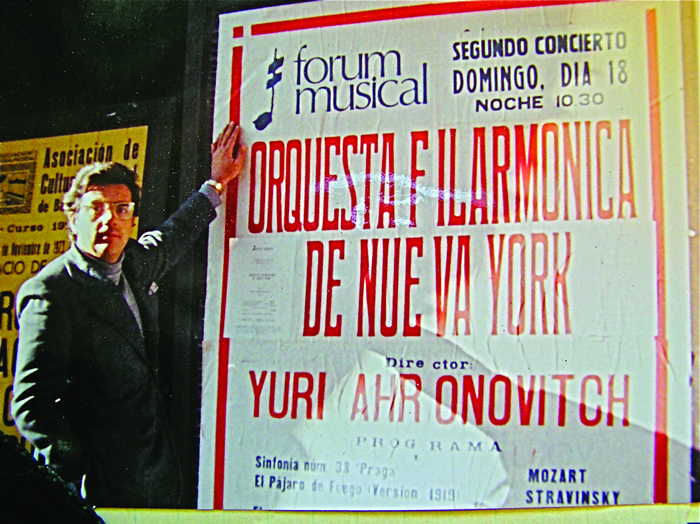Allegro
Making History
Volume 111, No. 2February, 2011
 Gabriel Banat and a poster advertising the New York Philharmonic’s tour of Madrid in 1973. |
When New York Philharmonic management forced a strike in 1973, musicians organized their own tour – a one-of-a-kind event. A new book about those days omits some important details.
As a violinist with the New York Philharmonic for 23 years (1970 to 1993) I was looking forward with interest to reading Mr. Canarina’s new book, “The New York Philharmonic, From Bernstein to Maazel,” intended as a sequel to Howard Shanet’s excellent account, “Philharmonic: A History of New York’s Orchestra.”
Alas, while well written and handsomely produced, Mr. Canarina’s opus is disappointing, compared to Mr. Shanet’s.
Mr. Shanet’s book is a fascinating account of the orchestra’s development along artistic, social and financial lines and relegates its comprehensive lists of programs, personnel and management to its massive back matter.
In contrast, Mr. Canarina’s book lines up the orchestra’s performances in chronological order, each tagged with a sound bite from the review of the New York Times. As an active participant for over two decades in virtually all of these performances, my interest was piqued. I enjoyed remembering the concerts, some of which were notable for their excellence and some for their flaws. However, the week-by-week succession of programs eventually became somewhat monotonous to read.
An additional flaw, at least from my point of view as a musician in the orchestra, was the author’s tendency to sanitize its history in favor of the management and the board.
A glaring example of that tendency was the treatment of an extraordinary event featured prominently on the dust jacket of the book as, “…the Philharmonic’s 1973 tour of Spain, Portugal and the Canary Islands, undertaken solely on the initiative of its musicians, without benefit or support from management.”
As an active participant in that undertaking, I was disappointed by Mr. Canarina’s account of that incident, unique in the annals of symphony orchestras.
I was amazed to find that, despite its prominence in the blurb, the author disposes of the episode in merely 15 lines. But I was mystified and dismayed to read the author crediting the wrong person with the management of the tour. “Most of the arrangements and logistics for the tour,” he claims, “were in the capable hands of John Shaeffer, the orchestra’s double bassist and assistant personnel manager, who earned much praise from his colleagues for his yeoman efforts.” He implies that the management had something to do with the tour, which is false.
In fact, having been elected by my colleagues to head our Benefit Performance Committee for the duration of the strike, I first obtained Carnegie Hall from Isaac Stern for a successful benefit concert, but then found myself unable to obtain engagements for the orchestra, due to a hostile telephone campaign by members of the Philharmonic board that Max Arons, then president of Local 802, deemed “a secondary boycott.”
It was at that time that I contacted Alfonso Aijon, the concert manager I met in Madrid, who had told me of his ambition of taking the New York Philharmonic on an Iberian tour.
As a result of that phone call, supported by my committee (which eventually included Johnny Shaeffer), I worked the telephone with Madrid and Lisbon, 24/7.
Incredibly, all the details, concerts, programs, conductor and finances were planned and executed in only 12 days – without the support of the array of assistant managers and secretaries available to management.
Thus, eight weeks into the strike, the orchestra embarked on a ten-day tour of eight concerts, returning with a net profit of $75,000 or about $750 for each of my colleagues, which was welcome indeed after going without income for nearly ten weeks.
It is unclear whether documents in a file attesting to the facts about the tour, deposited by me in the Philharmonic’s archives, were available to Mr. Canarina.
According to a well-informed source, the file I deposited at the Philharmonic Archives had been labeled “restricted.”
It appears that the Philharmonic management’s sensitivity about the musicians of the orchestra carrying out a successful concert tour on their own, helped obfuscate the most important lesson: the independent nature of our tour. A pity.
Memories are short. Therefore, I am all the more gratified by the warm support expressed by many of my colleagues who remember the way it really happened.
I am also content knowing that by earning respect for the musicians, our example had a positive effect on the relationship between management and orchestra not only at the New York Philharmonic, but at many other American symphony orchestras.
For more information, please see this Web site I’ve set up: www.NYPhilharmonic1973striketour.com
